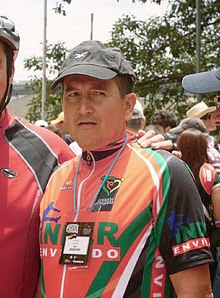 |
| Cyclist Rigoberto Urán, whose father was murdered by paramilitaries. |
But Urán had to climb over more than hills to achieve cycling greatness. He also had to overcome illness, poverty and the tragedy of Colombia's armed conflict.
Born in 1987 in the municipality of Urrao, Antioquia province, Urán grew up poor, helping his father to collect milk from farms and sell lottery tickets. The young Urán suffered from asthma, and to cure this his father took him cycling thru the region's hills when the boy was 13. The exercise soon helped cure the asthma.
However, like much of Colombia, the Urrao region was roamed by violent bands of leftist guerrillas and right-wing paramilitaries. One day, the elder Urán - also named Rigoberto - went out on a training ride and encountered an illegal paramilitary checkpoint. Altho what happened next is apparently uncertain, the younger Urán says that the paramilitaries forced his father and other kidnappees to steal cattle for them - and then killed the men.
Fatherless, the 14-year-old Urán was forced to support his family by selling lottery tickets. Nevertheless, he continued training, and soon after was signed by the Orgullo Paisa racing team. Now, he supported his family with his cycling income.
 |
| Luis 'Lucho' Herrera |
Other Colombian cyclists' scrapes with the conflict have fortunately not been so tragic. Luis 'Lucho' Herrera was a legendary climber who achieved immortality in 1987 by winning the Vuelta a España. He retired in 1992 to dedicate himself to his family.
However, in 2000 Herrera was kidnapped by guerrillas. The kidnapping lasted only one day however. According to one report I read, only after the kidnapping did the guerrillas discover who they were holding. They then asked their captive to recount his racing glories, and freed him after only 24 hours, apparently embarrassed about having kidnapped a national hero.
Also in 2000, fellow cyclist Oliverio Rincón was kidnapped twice, once together with his family, by the ELN and later by the FARC guerrillas. The first time, he was held for a week, and the second for only one day. After his second kidnapping, Rincón said that the guerrillas apologized to him.
The kidnappers "told me that I wasn't the person they were looking for, that it was a mistake and that they were very sorry about it," Rincon said.
Blog by Mike Ceaser, of Bogotá Bike Tours




